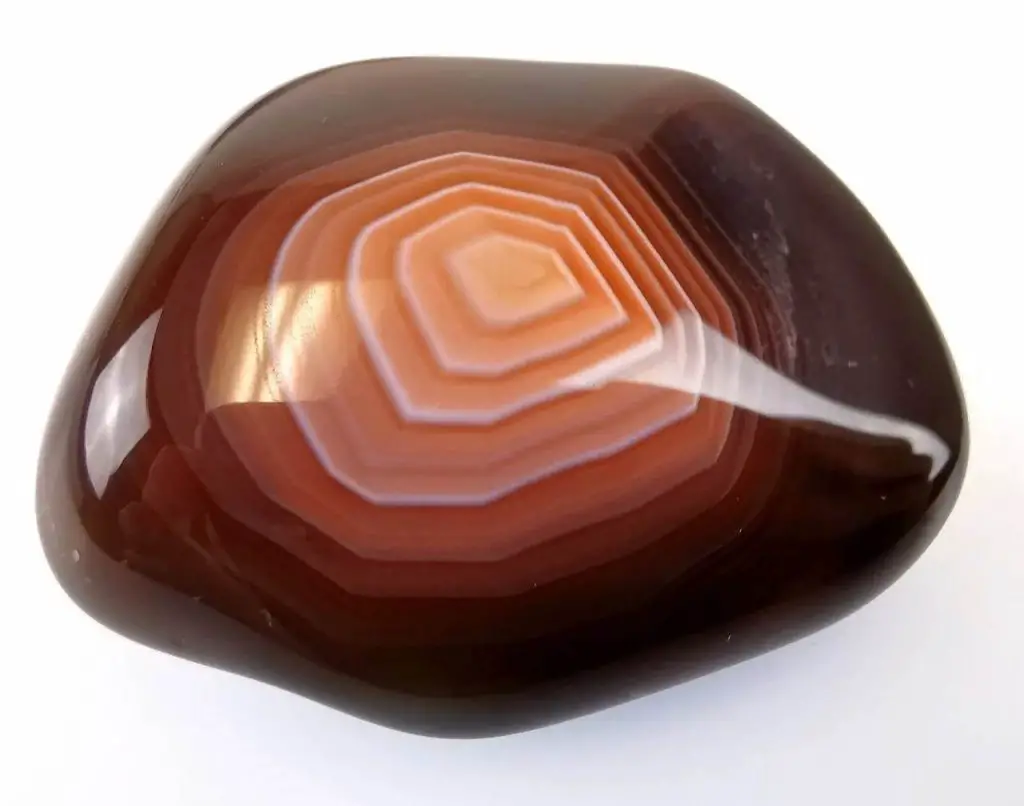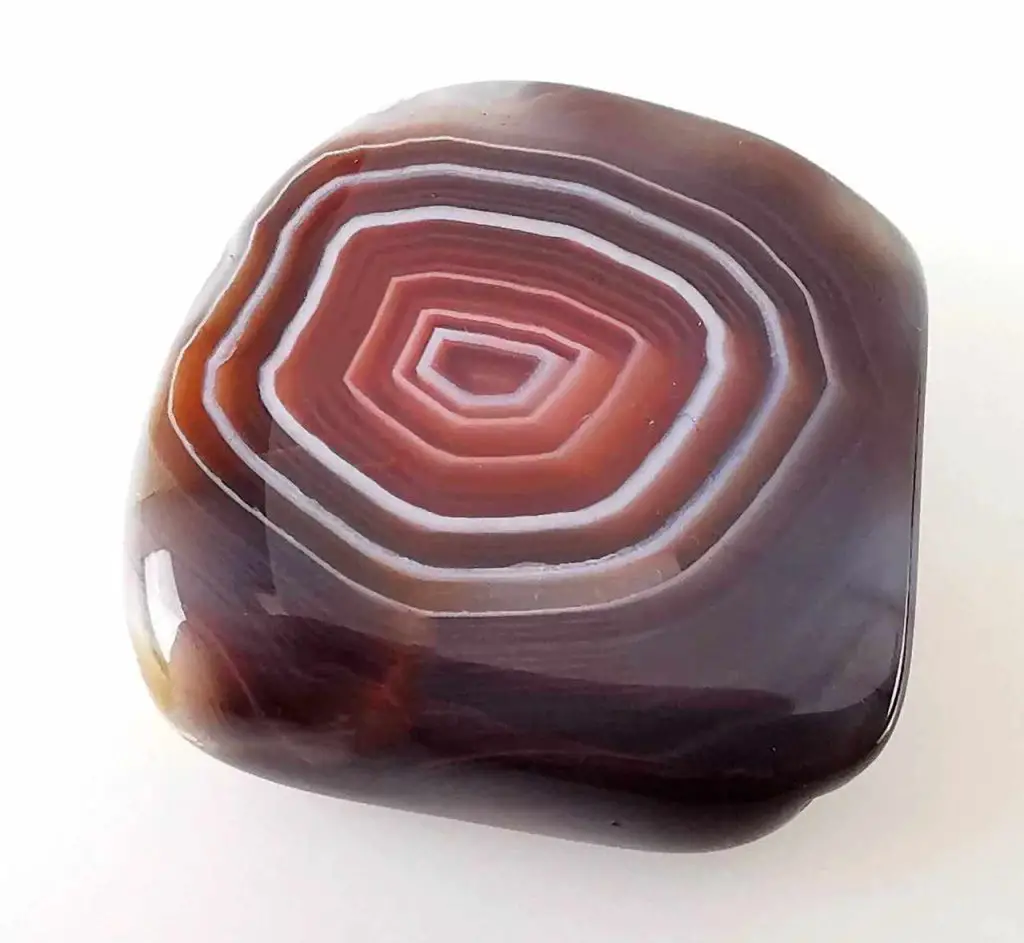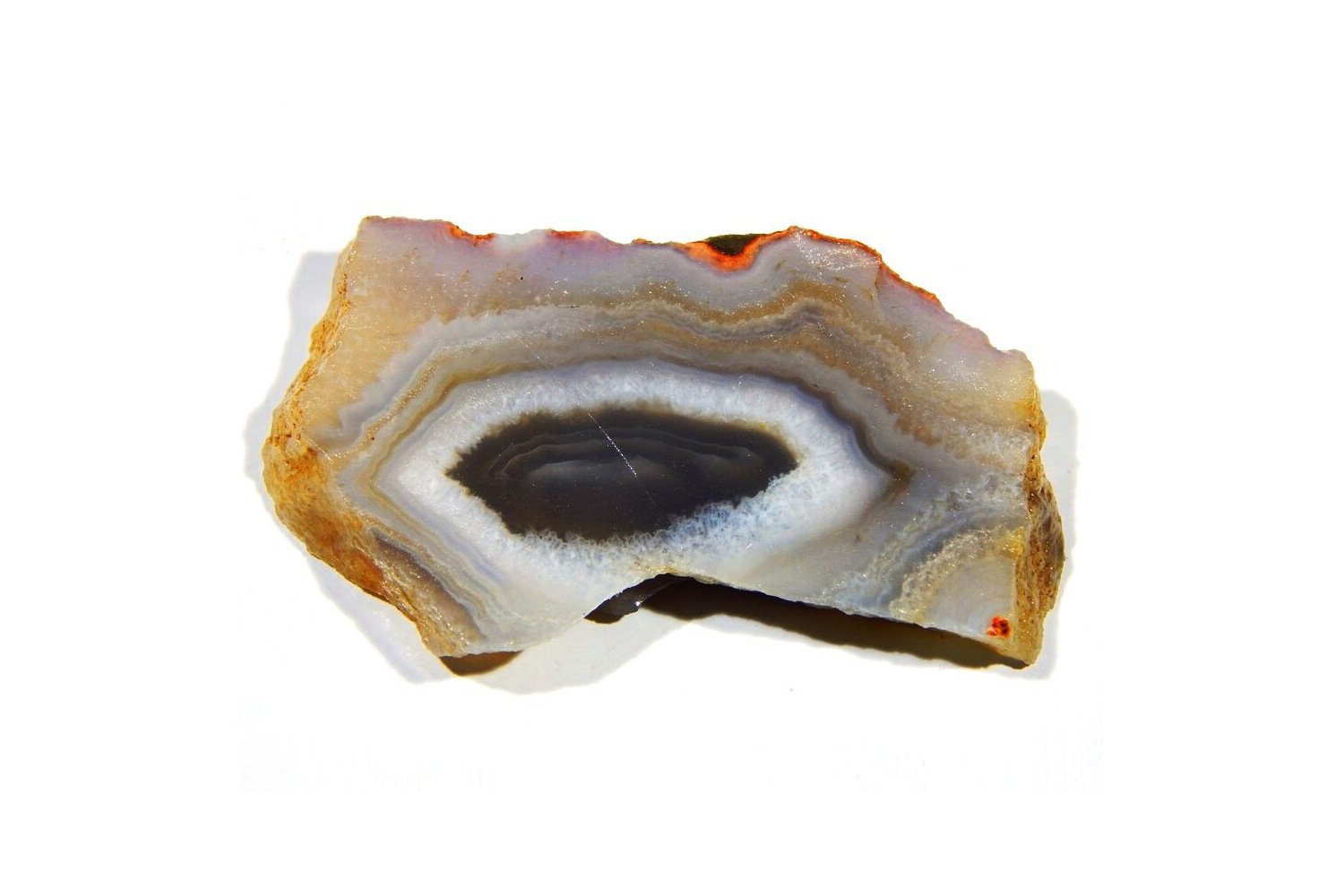Emerald. Ruby. Sapphire. Diamond. Pearl. These are a couple of easy answers that would likely come up if random people on the street were asked to name gems or jewelry. A name that probably wouldn’t be mentioned is Botswana agate – not an unknown stone by any means, but far from a common association people might make given the chance. That could be because it’s among the rarest forms of agate. Whatever the reason, it’s a gemstone worth learning more about.
Meaning
Technically speaking, the name Botswana agate doesn’t actually mean anything in the sense that, say, padparadscha (another gem) roughly translates to “aquatic lotus blossom.” Even so, when combined, the components of the name do create a meaning of sorts.

Agate is so-called because Theophrastus, a Greek naturalist and philosopher who studied under both the more generally known Plato and Aristotle, spotted the stone on the shoreline of the Achates River in Sicily. The river goes by a different name now, but back in the 3rd or 4th century BC when Theophrastus was around, it was the Achates. “Achates” became “agate,” and that was that.
Botswana is, quite simply, a country (which will be discussed a bit more later in the article). Put that together with Theophrastus’s chosen name for the stone, and you have the meaning: agate from Botswana.
Properties
Physical Properties
Botswana agate is considered quite beautiful amongst peers, and much of the reasoning behind that is based on the gemstone’s physical aspects.
The origin of the stone is key to fully understanding and appreciating its unrivaled beauty. Nearly 200 million years ago, active volcanoes in what is now known as Botswana erupted, swathing the landscape in boiling-hot lava. The lava flow wasn’t fast, however, and with time, it began layering over itself. Layer after layer, the pressure and weight increased, causing openings in the lava beneath that had already cooled.
In these openings, further layers were able to form, to become round like stones, and then actually become stones once cooled and settled. This long process of layering and cooling is what made Botswana agates what they are today. And it’s why they’re banded – definitely their most recognizable feature.
As with most jewels, color is one of the most important details to discuss, if for no other reason than it’s often the primary thing people notice upon first glance. The intricate bands of Botswana agate come in an array of colors: white, black, shades of gray, salmon pink, muted brown, and apricot (or yellow-orange). Which colors appear to change from stone to stone, as well as how they interact with one another based on the banding. It’s always interesting to see which colors serve as the “background,” per se, and which steal the spotlight upfront. The amount of variation means that it can be hard to choose just one Botswana agate and call it a day!
The colors stand out enough on their own thanks to the naturally occurring bands and patterns of Botswana agate, but carving and cutting have been used to highlight one or more layers. In the past, the stone was often carved in the cameo (raised image) and intaglio (engraved image) styles on amulets and talismans. Neither style emphasizes facets, and that attitude has heavily influenced modern styling. There aren’t really facets to emphasize in the first place, anyway, since Botswana agate is naturally round – more like a stereotypical stone than a gem, though this article uses the terms interchangeably. This makes cabochon an ideal shape for the stone, giving it a polished and clean look.
Botswana agate is also known as the Sunset Stone, and not because of any of its colors. Due to its waxy luster, relative translucency, and opaqueness, the stone is excellent at retaining sunlight. That means it looks best on a bright, cloudless day when the sun’s rays are constantly interacting with the surface of the gem.
Metaphysical Properties
There’s a separate discussion to be had about Botswana agate, one that lies outside the realm of the silica and quartz layers it’s composed of. It’s time to talk about the stone’s metaphysical properties – and they are legion, so strap in.
Botswana agate is a protective stone, to the point where one might even call it overprotective. Some of its protective tendencies are linked with the conditions older cultures were more prone to shielding from powerful storms, resistance against thirst, and safety on choppy seas. If Botswana agates had an “eye” (that is, if the bands morphed during formation to take an eye shape), some cultures believed it would watch over them, defending against bad influences and potential injuries. The eye was – and is – also a symbol of luck, great to have when gambling or trying a hand at the lottery.
In a modern context, Botswana agate is protective in different ways: keeping away spiders, nullifying stress and bad dreams, ensuring safety during travel (preventing traffic accidents, for example), and guarding the home against fire. That protection can extend directly to health, as well – physical and mental. In terms of the body, a few of the things it is capable of include keeping skin smooth and healthy, reducing the risk of cardiovascular issues, and preventing sleepwalking. When it comes to the mind, Botswana agate is especially prevalent in helping with depression or dangerous thought patterns, making it beneficial during times of stress or grieving.
In its power to help people charge through negative thoughts, Botswana agate is considered potent when making changes or going through transitionary periods in life. It encourages the mind to clear up, removing mental obstacles that may have been set down without consciously realizing it. That sort of positive thinking leads to greater drive and focus, putting the wearer in control of their own life with renewed confidence and clarity. Discretion, decision-making, and deliberation should all see a boost. Obviously, that would benefit just about anyone, but those who require concentration and sound judgment in their work (such as an entrepreneur) or at home (the matriarch of the household, perhaps) would benefit especially.
The energy of Botswana agate is also beneficial for people looking to improve or make relationships. This doesn’t just mean love. In fact, one boon of the stone, in particular, may come off as unexpected: younger people facing difficulties with bullies may be able to overcome their pain and find supportive friends.
But yes, Botswana agate can work with searching for a love interest as well. It allows those looking for love to sense who might align with them spiritually, even through online dating. And just like how kids place their teeth under their pillows for the Tooth Fairy to find and replace with a treat, placing the stone under a pillow can formulate dreams that could hint at where to find love, or who to find it in.
Some of the colors of Botswana agate have special properties worth mentioning. Pink bands are largely related to love, both new and old; they aid in finding new significant others, as well as getting over past ones. It’s calming and reflective, strengthening one’s determination and commitment. Brown and apricot bands are grounding, reinforcing a sense of stability and comfort. These colors make it easier to stay composed, relaxed, and more connected with your surroundings. Lighter gray bands stress the importance of the inner self, bolstering it in the process. Those wondering about patterns or purpose will value such shades of gray the most.

Where to Buy Botswana Agate?
Usually Etsy or Amazon is a good idea. Etsy is the leading online global marketplace of handmade, vintage, and creative goods. Amazon is one of the largest global online marketplaces. Both of them are reliable and easy to find your favorite items there.
Botswana Agate In Jewelry Uses
With as many colors as the stone boasts, it’s only natural that the selection of Botswana agate jewelry is one of the most diverse on the market. Necklaces, rings, and bracelets are particularly popular.
Botswana agate necklaces are often beaded, sometimes with each bead exhibiting a different color of the gem’s wide-ranging spectrum. The beads can come in any number of shapes and sizes, from rounded to flattened to a mix of both. Additionally, the way the beads are laid out can be as simple (right along the string/metal) or as complex (spread like wings) as you can imagine.
Pendant necklaces, on the other hand, feature one prominent Botswana agate rather than a bunch of them strung together. Pendant necklaces are also more likely to feature a stone with an “eye,” so those looking to get lucky should veer in that direction. And of course, pendants may be more than just a regular stone, but a carving of some sort, like a dragon or an intricate design.
Botswana agate rings aren’t as varied as necklaces, if only by the nature of the fact that they typically feature only one stone, whereas necklaces can hold many. (Of course, it’s not like you can’t wear more than one ring, so that doesn’t matter in any grand capacity.) It’s still Botswana agate, though; the colors impress just as much and the metaphysical benefits are as present as ever. The one advantage rings have over necklaces is that generally speaking, the gemstones are larger and showier. Cabochon and oval cuts are the norms, but square rings aren’t unheard of, and give off a much different vibe than their rounded cousins.
Botswana agate bracelets are – at least in the eyes of those who sell them – most closely tied with the metaphysical realm. That shouldn’t influence a buyer’s decision, as Botswana agate is Botswana agate either way. Regardless, there are some truly incredible bracelets to choose from. There are, of course, standard string bracelets, often adorned with simple rounded stones. There are “chunky” bracelets, with Botswana agates shaped something like fancy skipping stones; these are obviously a bit heavier. And then there are the more complex designs, which range from featuring pendants to ones that you have to see to believe.
It goes without saying that there are more kinds of Botswana agate jewelry than just necklaces, rings, and bracelets. Some even choose to purchase the stone itself, rather than as jewelry. In all its available forms, however, it is a lovely gemstone to own.
Where Does Botswana Agate Come From?
Agates are found in a multitude of locations around the globe under a number of names, from the Coldwater agates of Lake Michigan to the Cyclops agates of Mexico. As briefly mentioned earlier, Botswana agate in particular is found in the nominal country.
Located near the southern tip of the African continent, Botswana experienced volcanic activity close to 200 million years ago, forming the precious agate in the process. Millions of years later, humans discovered the stone there, and it became essential to the culture of the time. Local tribes even used it in ceremonies they performed, mostly to promote fertility and safe conception.
Today, most Botswana agate is mined in the Bobonong district, near the eastern end of the country where it borders Zimbabwe.
How Much Is Botswana Agate Worth?
Botswana agate is a semi-precious gemstone, so depending on the seller, the quality, and the type (which encompasses colors, banding patterns, and jewelry versus lone stones), the price range can differ dramatically. Whether the stone is real or not will obviously also affect the price. But essentially, with this stone, you get what you pay for.
Examples might help clarify the potential price disparity buyers will encounter.
Necklaces: Generally speaking, Botswana agate pendant necklaces can sell for anywhere between $30 and $100. A high-end neck clasp, held between two 18K gold rings studded with tiny diamonds will cost somewhere around $1,500.
Rings: Less costly Botswana agate rings are usually in the $25 to $60 range. More expensive variations can cut close to $250, or even $600.
Bracelets: Botswana agate bracelets start between $15 and $50, but can go up to around $250 if especially well made.
How to Identify Botswana Agate?
The most efficient way to identify Botswana agate is to go to the experts – gemologists like those at the AGTA (American Gem Trade Association) or the GIA (Gemological Institute of America).
Other than that, there aren’t many specific ways to “test” Botswana agate’s authenticity. Be sure to purchase it from a trusted seller, and to check it against all the physical properties discussed earlier.
How to Use Botswana Agate?
With Botswana agate being such a variable stone in terms of color and banding combinations, choosing what to pair it with and how to wear it can be difficult undertakings. Hopefully, the following suggestions prove a useful guide for those struggling to decide.
It should be noted that Botswana agate is considered an excellent gem for men to wear, rather than the plainer jewelry widely available to them. Because men typically wear simpler clothing than women, the colorful but not overwrought patterns of the stone can serve as a fine complement to their daily wear. For those men not into jewelry, Botswana agate could even work as a belt buckle or tie tack.
How to Cleanse Botswana Agate?
Botswana agate is hard enough that it won’t break easily (between 6.5-7 on the Mohs hardness scale), but it’s nowhere near as durable as diamonds. That means taking special care while cleaning it. Luckily, it isn’t a difficult process in the slightest. All that’s needed is soap, water, and a toothbrush or soft cloth. Let it soak in the soap-filled water, keeping the temperature warm (but not hot!). This will remove most of the grime; whatever’s left, just wipe off with the toothbrush or cloth. Rinse it, dry it, and the stone should be back to square one.
Aside from cleaning Botswana agate, knowing ways to keep it clean isn’t a horrible idea. For one thing, don’t expose it to heat for too long; cleaning it with steam, for example, is a quick way to ruin the stone. Sweat can also have poor effects on the gem, so be sure to remove any Botswana agate jewelry when engaging in any sort of rigorous physical activity. Interestingly, makeup can diminish the stone’s polish as well, so put it on after applying cosmetics. Lastly, when storing Botswana agate, do so in a separate bag or container, so as not to have it rub up and get scratched against other gems.
The Best Combinations With Botswana Agate
For those concerned with color contrasts, Botswana agate works with a few different hues. More gently colored stones (largely gray ones, for instance) could easily fit in with warmer-colored gems, such as brecciated red jasper. Botswana agates with pinker or apricot bands would stand out starkly against something like black onyx or white mountain jade without overpowering either. This all applies to outfit choice as well. So, as an example, a woman in a black dress might want a more lightly colored Botswana agate necklace.
Personal preference matters, though, as do the metaphysical implications of the stone’s various colors. There’s a lot to take into consideration, to be sure.
Final Words
Botswana agate may not be as valuable as diamonds or rubies, but beauty is in the eye of the beholder, no? It’s a beautiful gemstone in its own right, one that boasts as many colors as it does metaphysical benefits. Its worth is defined by what the buyer makes of it, how they wear it, and how they take care of it – a stone as humble and honest as its origins.

